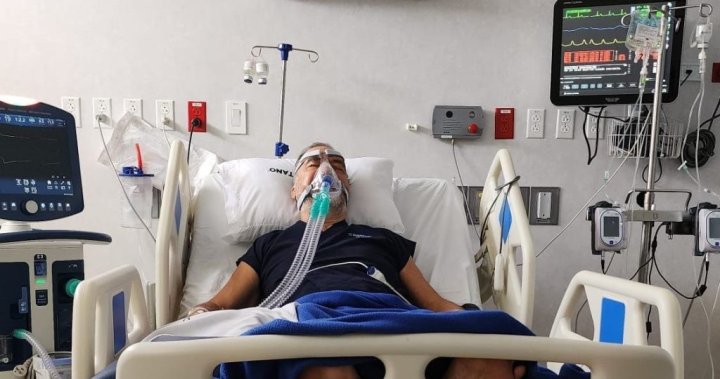Back in March of 2020, Tim Chan was preparing to weather a storm that never came.
A resident at the Montreal Chinese Hospital, a long-term care home located near Chinatown that caters to clients of Asian heritage, he feared the worst during the first wave of the COVID-19 pandemic, during which nearly 4,000 residents in CHSLDs across Quebec died.
“I feel really nervous the first time,” Chan, 96, said.
But due to early intervention and a collective effort from staff, the home managed to keep the virus out of its walls entirely, reporting zero cases during the first wave of the pandemic.
Now, more than a year and a half into the pandemic, the CHSLD has recorded only four COVID-19 cases, no outbreaks, and a single death.
The home’s efforts were praised by Quebec coroner Géhane Kamel earlier this month at the inquiry into deaths in Quebec’s long-term care homes in the spring of 2020. Kamel called the Chinese Hospital an “extraordinary success story.”
Now, employees and management have been awarded the Medal of the National Assembly in recognition of their “determination and dedication to taking care of our elders,” the bronze medal reads.
“They did a good job very fast, so the government gave an award for this,” Chan said, smiling.
Sandra Lavoie, the director of the CHSLD, says their success is due to the rapid response of staff to the virus — and to how serious they were about precautionary measures.
She says that because most of her staff and residents had connections to Asia, they were aware of COVID-19 earlier than many other Quebecers.
“Our employees were very sensitive to the virus since they have family and friends in China,” she said. “So it’s like if they were seeing what would be coming here in Quebec and in Canada, four to six weeks ahead.”
Early jump on masking, handwashing
In January 2020, weeks before COVID-19 was widely known and before it was present in Quebec, employees at the 128-bed long-term care facility were already voluntarily bringing in their own personal protective equipment and upping their handwashing.
Ponora Ang, president of the Montreal Chinese Hospital Foundation, said the threat of COVID-19 was very real for staff at the home in the early months.
“It was not just an article in the press saying that it was a pandemic. They had families there, they knew over people there,” he said.
A number of staff visited China in January for the Lunar New Year and saw first-hand the high transmissibility and effects of the virus on their loved ones.
“So that created an atmosphere where people wanted to be much more prudent,” Ang said.
Jeremy Tsang, a nurse assistant at the Chinese Hospital, said the hyper-vigilance of workers played a crucial role in curbing the spread of COVID-19 in the home.
“People were starting to stock up on say, using masks, and excessive hand hygiene, and we also asked our superiors whether we can have the mask on and also to have all this excessive cleaning during work time,” he explained.
This all came well before any mandate from the provincial Health Ministry and any shortage of PPE.
Meanwhile, in other CHSLDs, the coroner’s inquiry has heard that workers were forbidden to wear masks and other PPE unless they had to be in direct contact with a patient.
Good communication with families
Terry Chow, president of the users’ committee at the Chinese Hospital, said workers did everything to limit transmission of the virus in the home, including cancelling the much-anticipated Asian New Year celebrations.
“Of course, the families were quite anxious [about COVID-19],” he said, adding visitors inside the home were also limited around that time.
“I would say one of the most important things is good communication between the management and the hospital and with the families,” Chow said.
He said staff would phone residents’ families once a week to update them with any news. Employees would also explain why the precautionary measures were necessary to the residents and their families.
“So I think working together, that’s what happened,” he said.
Community comes together
Lavoie said cultural ties between the community and the residence meant that there was less reliance on workers from outside placement agencies, reducing the movement between care homes.
Ang, president of the Foundation, says these community ties were critical in securing adequate funding for the home amid the pandemic. That helped buy PPE for staff and iPads to allow families to video chat with residents regularly.
“What we learned from that situation is that the Chinese and the Asian communities, the local communities, were extremely, extremely supportive to the hospital,” said Ang, adding the various community organizations contributed despite their own financial difficulties.
“The Montreal Chinese Hospital is a stone in this community and they were there for us,” he said.
Lavoie says the home worked together with employees, volunteers, and management to keep the virus out, which is a lesson she says she will carry with her in the future.
“We had a successful story because all of us would work together… it’s really a team effort.”




More Stories
‘Learn to walk again’: Sask. doctor tells story of miracle recovery from deadly heart condition
Canadians more likely to eat food past best-before date. What are the risks? – National | Globalnews.ca
What a urologist wants you to know about male infertility